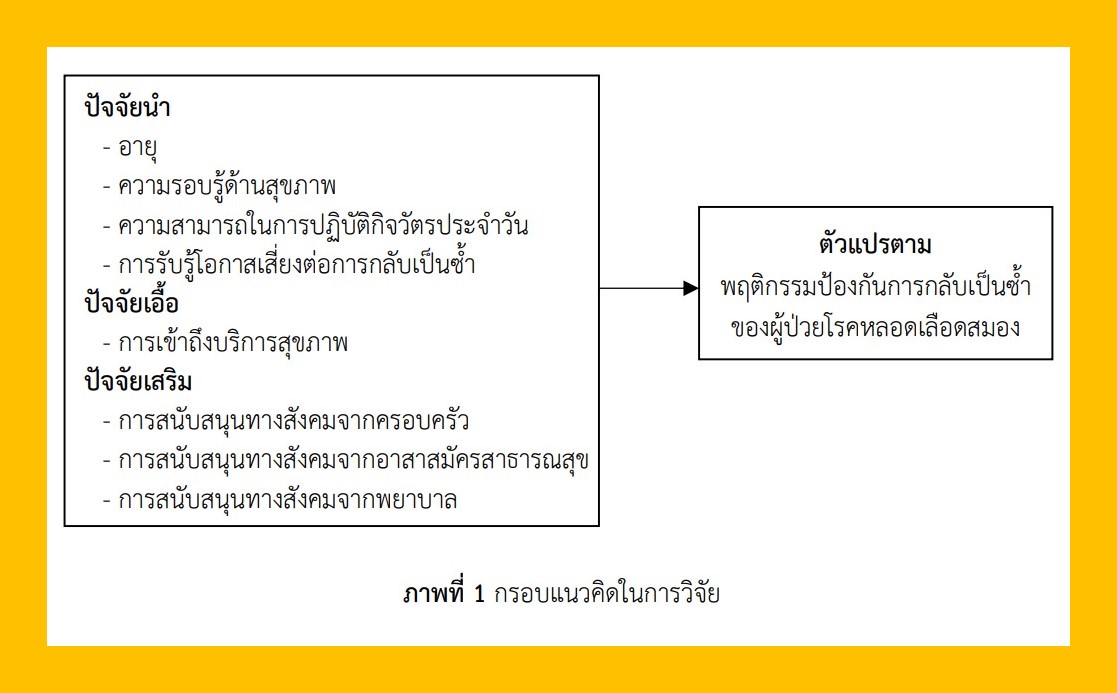ปัจจัยที่มีอิทธิพลต่อพฤติกรรมป้องกันการกลับเป็นซ้ำของผู้ป่วยโรคหลอดเลือดสมองในสถานการณ์การแพร่ระบาดของโรคติดเชื้อ COVID-19 กรุงเทพมหานคร
คำสำคัญ:
การกลับเป็นซ้ำโรคหลอดเลือดสมอง, พฤติกรรมป้องกัน, ผู้ป่วยโรคหลอดเลือดสมอง, PRECEDE-PROCEED frameworkบทคัดย่อ
การวิจัยแบบพรรณนาเชิงทำนายนี้ เพื่อศึกษาพฤติกรรมป้องกันการกลับเป็นซ้ำ และปัจจัยที่มีอิทธิพลของผู้ป่วยโรคหลอดเลือดสมองในสถานการณ์การแพร่ระบาด COVID-19 ประยุกต์ PRECEDE-PROCEED เป็นกรอบแนวคิด กลุ่มตัวอย่าง คือ ผู้ป่วยโรคหลอดเลือดสมองจำนวน 148 ราย ได้จากการสุ่มแบบหลายขั้นตอนจากชุมชนในกรุงเทพมหานคร เครื่องมือรวบรวมข้อมูล คือ 1) ลักษณะประชากร 2) ความสามารถในการปฏิบัติกิจวัตรประจำวัน 3) ความรอบรู้ด้านสุขภาพ 4) การรับรู้โอกาสเสี่ยงต่อการกลับเป็นซ้ำ 5) การเข้าถึงบริการสุขภาพ 6) การสนับสนุนทางสังคม และ 7) พฤติกรรมป้องกันโรคหลอดเลือดสมองซ้ำ เครื่องมือที่ 3 - 7 มีค่าดัชนีความตรงตามเนื้อหา .80, 1.00, .80, .80 และ .92 ตามลำดับ ค่าสัมประสิทธิ์แอลฟาครอนบาค .96, .78, .76, .73 และ .73 ตามลำดับ วิเคราะห์ด้วยสถิติเชิงพรรณนา สัมประสิทธิ์สหสัมพันธ์ และสถิติถดถอยพหุคูณแบบขั้นตอน
ผลการวิจัย ผู้ป่วยมีพฤติกรรมป้องกันการกลับเป็นซ้ำระดับมาก (Mean 73.62 ± 8.46) อายุการรับรู้โอกาสเสี่ยงต่อการกลับเป็นซ้ำ ความรอบรู้ด้านสุขภาพ การเข้าถึงบริการสุขภาพ และการสนับสนุนทางสังคมจากอาสาสมัครสาธารณสุข เป็นปัจจัยที่มีอิทธิพลอย่างมีนัยสำคัญต่อพฤติกรรมป้องกันการกลับเป็นซ้ำ สามารถร่วมอธิบายได้ ร้อยละ 45.20 (adj R2 = .452) เพื่อให้ผู้ป่วยมีพฤติกรรมป้องกันที่เหมาะสม ควรส่งเสริมความรอบรู้ด้านสุขภาพ การรับรู้โอกาสกลับเป็นซ้ำ การเข้าถึงบริการสุขภาพ โดยคำนึงถึงอายุของผู้ป่วย และเพิ่มพูนความสามารถแก่อาสาสมัครสาธารณสุข
เอกสารอ้างอิง
Department of Disease Control. Department of Disease Control campaign for world paralysis day 2019 for people to recognize the warning signs of stroke reduce the risk of paralysis [Internet]. 2019 [cited 2022 Jul 3]. Available from: https://ddc.moph.go.th/brc/news.php?news=10024&deptcode=brc (in Thai)
Strategy and Planning Division. Number and inpatient rate in 2016 - 2018 (hypertension, diabetes, cardiovascular, cerebrovascular, COPD) [Internet]. 2019 [cited 2021 Dec 25]. Available from: http://www.thaincd.com/2016/mission/documents-detail.php?id=13684&tid=32&gid=1-020 (in Thai)
Strategy and Planning Division. Number and death rate of non-communicable diseases 2016 - 2018 (hypertension, diabetes, cardiovascular, cerebrovascular, COPD) [Internet]. 2019 [cited 2021 Dec 25]. Available from: http://www.thaincd.com/2016/mission/documents-detail.php?id=13653&tid=32&gid=1-020 (in Thai)
World Health Organization, Noncommunicable Diseases and Mental Health Cluster. WHO STEPS stroke manual : the WHO STEP wise approach to stroke surveillance / noncommunicable diseases and mental health, World Health Organization [Internet]. 2006 [cited 2021 Aug 9]. Available from: https://iris.who.int/handle/10665/43420
Chuenjairuang P, Iamsamai S. The meaning and management of suffering from stroke disability in persons with stroke. Thai Pharmaceutical and Health Science Journal 2014;9(4):170-7. (in Thai)
Potisat S, Kunee N, Udomchairat R, Prichaichywithy P, Khonlaeaid S, Mirattanaphrai S, et al. Literature review: the current situation and care model of non-communicable diseases. Bangkok: Art Qualified; 2014. (in Thai)
Jearanaisilp S. TIA- transient ischemic attack. Journal of Thai Stroke Society 2015;14(3):153-65. (in Thai)
Khumsa-ard S, Thiangtham W, Suwan-ampai P. Behavior factors related to recurrent stroke. Journal of Public Health Nursing 2017;31 Suppl 1:S13-26. (in Thai)
Jittanoon P, Buapetch A, Saksorngmuang P, Arab W, Wongyongsil S, Wauters Y. Cerebrovascular knowledge and preventive behaviors of cerebrovascular risk group: a case study of Huinang sub-district, Trang province. Songklanagarind Journal of Nursing 2021;41(2):13-25. (in Thai)
BMA Data Center. Situation of the spread of viral infections Corona 2019 [Internet]. 2022 [cited 2022 Oct 20]. Available from: https://pr-bangkok.com/?page_id=994 (in Thai)
Fifi JT, Mocco J. COVID-19 related stroke in young individuals. The Lancet Neurology 2020;19(9):713-5. doi: 10.1016/S1474-4422(20)30272-6.
Public Health Nursing Division, Department of Health. Situation of stroke in the community of Bangkok. Oral session presented at: Summary of health status results. 2022 Apr 7; Bangkok. (in Thai)
Green LW, Kreuter M. Health program planning: an educational and ecological approach. 4th ed. New York: McGrew-Hill; 2005.
Klinsakorn C, Saetan S. Factors related to self-protective behavior of stroke with controlled hypertention patients who live in Danchang district, Suphanburi province. Journal of Council of Community Public Health 2020;2(2):62-77. (in Thai)
Ginggeaw S, Prasertsri N. The relationship between health literacy and health behaviors among older adults who have multi-morbidity. Nursing Journal of the Ministry of Public Health 2016;25(3):43-54. (in Thai)
Chaisawa N, Jindavong S. Factor relative to perceived self-care with stroke Krasaesin hospital for Songkhla. Princess of Naradhiwas University Journal 2017;9(3):70-82. (in Thai)
Sivapreeyagoon G. Self-care behaviors of elders in Mueang district, Surat Thani province. Journal of Health Research and Innovation 2020;3(1):1-14. (in Thai)
Inchai P, Jumniensuk A, Durongdej S, Sonthipho P, Bandit J, Eimsaard C. Self care behaviors among elderly people with chronic diseases in Pamok district, Angthong province. Journal of the Department of Medical Services 2018;43(4):100-4. (in Thai)
Jacob C. Statistical power analysis for the behavioral sciences. 2nd ed. Hillsdale, NJ: Lawrence Erlbaum Associates; 1988.
Intarakamhang U. Creating and developing of Thailand health literacy scales [Internet]. 2020 [cited 2022 Nov 2]. Available from: http://bsris.swu.ac.th/upload/268335.pdf (in Thai)
National Health Security Office. Public health long-term care system management support guide for elderly people with dependency on the national health insurance system [Internet]. 2016 [cited 2022 Nov 1]. Available from: https://www.nhso.go.th/storage/files/shares/PDF/fund_ltc13.pdf (in Thai)
Kongkaew O. Illness representation and recurrence prevention behaviors in elderly with stroke [Dissertation]. Songkhla: Prince of Songkla University; 2018. (in Thai)
Polit DF, Beck CT. The content validity index: are you sure you know what’s being reported? critique and recommendations. Research in Nursing and Health 2006;29(5):489-97. doi: 10.1002/nur.20147.
DeVon HA, Block ME, Moyle-Wright P, Ernst DM, Hayden SJ, Lazzara DJ, et al. A psychometric toolbox for testing validity and reliability. Journal of Nursing Scholarship 2007;39(2):155-64. doi: 10.1111/j.1547-5069.2007.00161.x.
Department of Health, Ministry of Public Health. Thai Health Literacy Survey (THL-S) of Thais aged 15 years and above, 2019 [Internet]. 2019 [cited 2022 Jul 10]. Available from: https://borc.anamai.moph.go.th/web-upload/24xe82d9421a764bd38b31a4171c44f37a6/tinymce/KPI/2565/KPI1_36/L2/1KPI1-36_2-2-8.pdf (in Thai)
Tantirittisak T. Clinicalpractice guidelines for ischemic stroke in the situation of the coronavirus 19 pandemic. Bangkok: Prasat Neurological Institute; 2020. (in Thai)

ดาวน์โหลด
เผยแพร่แล้ว
รูปแบบการอ้างอิง
ฉบับ
ประเภทบทความ
สัญญาอนุญาต
ลิขสิทธิ์ (c) 2023 วารสารเกื้อการุณย์

อนุญาตภายใต้เงื่อนไข Creative Commons Attribution-NonCommercial-NoDerivatives 4.0 International License.














